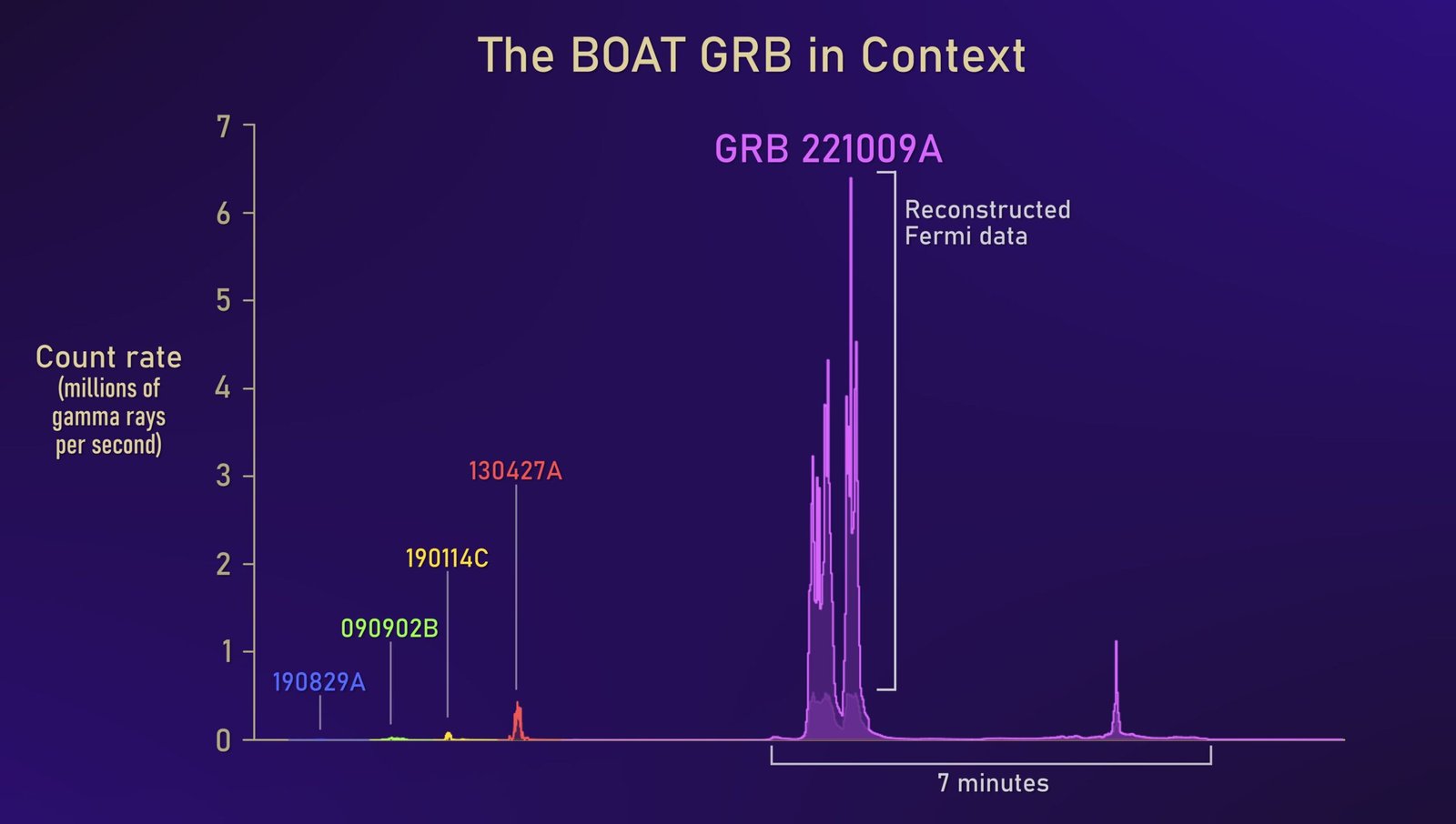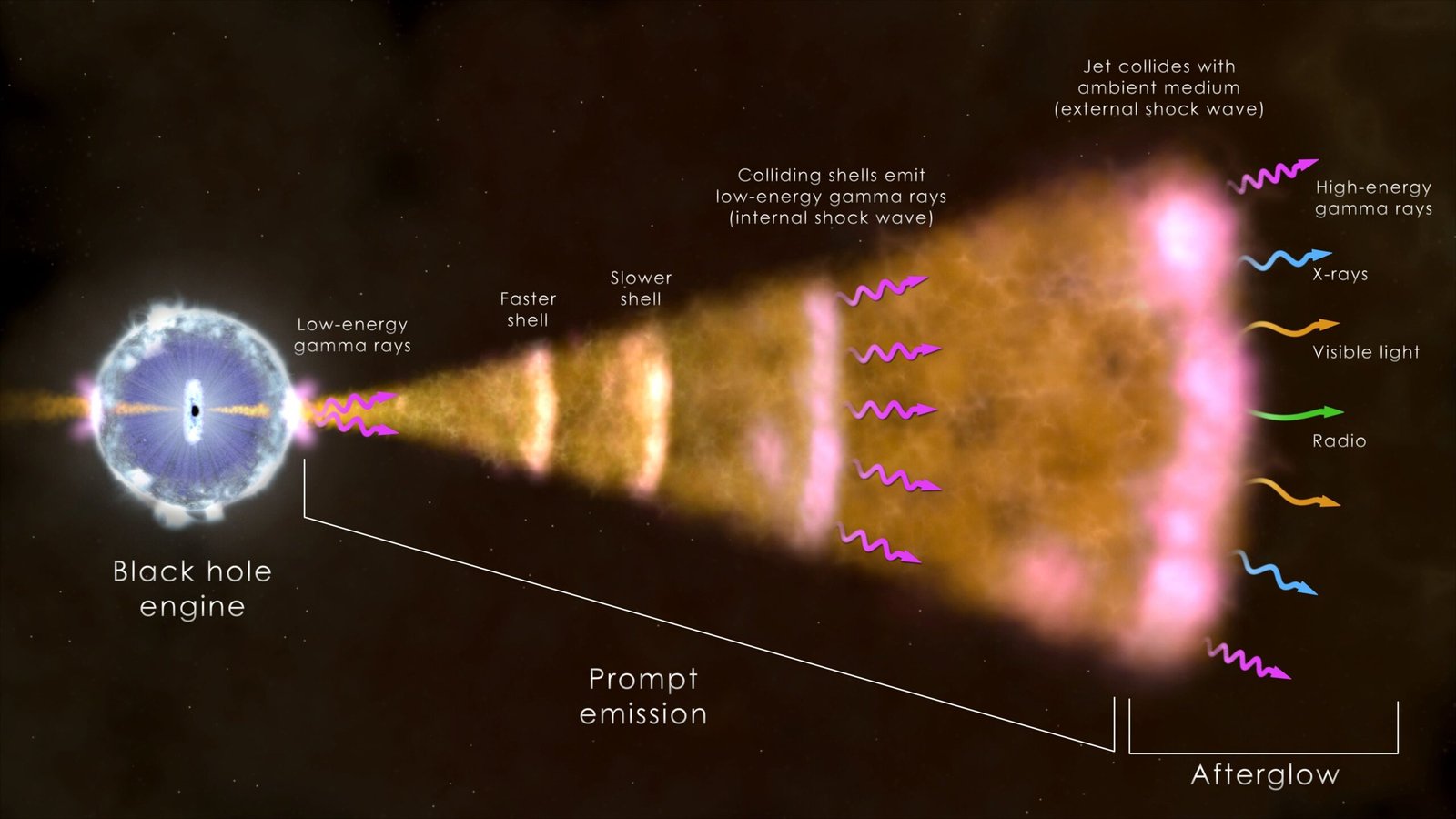A gamma-ray burst Gamma-Ray Burst emitted the BOAT, or “brightest of all time,” radiation pulse on October 9, 2022. This rare occurrence has piqued the interest of NASA scientists who have launched missions to study it. The burst was so powerful that it overwhelmed most gamma-ray instruments in space, making it challenging to record the actual intensity of the emission. However, US scientists were able to reconstruct the data using Fermi data. They contrasted their findings with Russian researchers examining Konus data and Chinese teams evaluating observations from their satellite’s GECAM-C detector and Insight-HXMT observatory equipment. Together, their findings revealed that the burst was 70 times brighter than any previously recorded, making it a significant event that may shed new light on the study of gamma-ray bursts and their impact on the universe.
The brightest burst of X-rays and gamma rays in a decade:
A group of astronomers has recently discovered the brightest burst of X-rays and gamma rays in a decade. Eric Burns, an assistant professor of physics and astronomy at Louisiana State University in Baton Rouge, led an analysis of about 7,000 Gamma-Ray Bursts, mainly detected by NASA’s Fermi Gamma-ray Space Telescope and the Russian Konus instrument on NASA’s Wind spacecraft. This analysis aimed to determine the frequency of such bright events, with their answer being once every 10,000 years. Burns says: “Gamma-Ray Burst 221009A was likely the brightest burst at X-ray and gamma-ray energies to occur since human civilization began.”
Further, he said that Gamma-Ray Burst 221009A was likely the brightest X-ray and gamma-ray burst since human civilization started. Burns and other scientists presented their results at the American Astronomical Society High Energy Astrophysics Division conference in Waikoloa, Hawaii. NASA and partner missions provided data on the burst from radio waves to gamma rays. Papers detailing the results presented at the meeting have appeared in a focus issue of The Astrophysical Journal Letters. After 1.9 billion years, Gamma-Ray Burst 221009A hit Earth. Scientists believe such blasts are black holes’ birth cries. As the black hole ingests the surrounding matter, it emits jets in opposite directions containing particles that accelerate to near the speed of light, piercing through the star and emitting X-rays and gamma rays as they travel through space.

Now we should know the,
Challenges in detecting a supernova associated with Gamma-Ray Burst 221009A:
The difficulty in detecting a supernova associated with Gamma-Ray Burst lies in the fact that a typically brightening supernova will accompany this type of Gamma-Ray Burst within a few weeks. But such an event has yet to be observed. The Gamma-Ray Burst happened a few degrees above the plane of our galaxy, where massive dust clouds may block light.
Andrew Levan is a professor of astrophysics at Radboud University in Nijmegen, Netherlands. He commented on the matter, stating that despite the brightness of the burst, we cannot confirm conclusively that a supernova occurred. To overcome this challenge, Levan led near- and mid-infrared observations using NASA’s James Webb Space Telescope and the Hubble Space Telescope. They better penetrate dust clouds than visible light. However, if a supernova is present, it would be very faint. Despite this, astronomers plan to continue observing regions over the coming months to determine if a supernova did occur or if the entire star collapsed into a black hole without exploding.
You might be wondering,
How Gamma-Ray Burst 221009A’s Afterglow Challenges Current Models of Gamma-Ray Burst Jets?
The afterglow of Gamma-Ray Burst 221009A has challenged current models of GRB jets. As the jets expand into the surrounding material, they produce a fading multiwavelength afterglow. Kate Alexander is an assistant professor at the University of Arizona. He explained that the burst provided an unprecedented opportunity to test the accuracy of afterglow models. However, the observations showed a new radio component that is not fully understood, which may indicate additional structure within the jet or the need to revise the current models of how GRB jets interact with their surroundings. Despite the unexpectedly dim radio afterglow, the GRB 221009A will remain detectable for years. As it will provide an opportunity to track the full life cycle of a powerful jet.
You also might be thinking,
How does Gamma Ray Burst help Probe Distant Dust Clouds in Our Galaxy with X-ray Rings?
Astronomers were able to use Gamma-Ray Burst 221009A to probe distant dust clouds in our galaxy through the presence of X-ray rings expanding from the burst’s location. Some early X-rays rebounded off dust layers, causing “light echoes” on Earth. This allowed scientists to recreate the burst’s early X-ray emission and locate our galaxy’s dust clouds. Sergio Campana is a research director at Brera Observatory in Italy. He explained that the rings provided information on how dust clouds scatter X-rays based on their distances, the sizes of the dust grains, and the X-ray energies. GRB 221009A is only the seventh gamma-ray that burst itself to display X-ray rings. And the echoes came from dust located between 700 and 61,000 light-years away.

Lastly, the question arises,
Do Black Holes Also Return Power to the Universe?
Gamma-Ray Burst 221009A provides an opportunity to explore the question of whether black holes also return power to the universe. According to Michela Negro, an astrophysicist at the University of Maryland and NASA’s Goddard Space Flight Center, her team used NASA’s Imaging X-ray Polarimetry Explorer to probe the dust rings and glimpse how the prompt emission was organized, which can give insights into how the jets form. The afterglow showed a tiny degree of polarization, showing that the jet was practically directly head-on. The scientists say that together with similar measurements using data from ESA’s INTEGRAL observatory, it may be possible to prove that trapping into the energy of a magnetic field the black hole’s spin has amplified the power of the BOAT’s jets. Thereby answering the question of whether black holes also return power to the universe.





